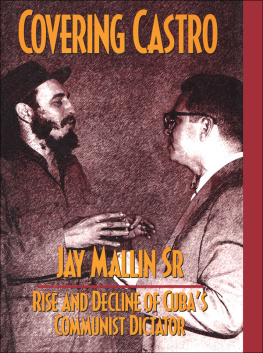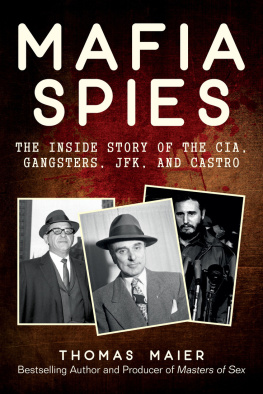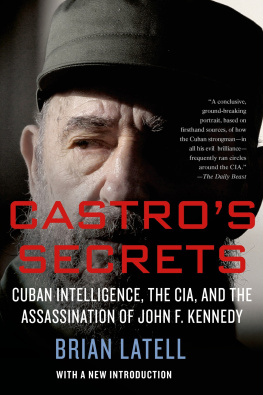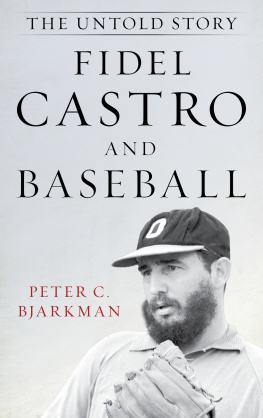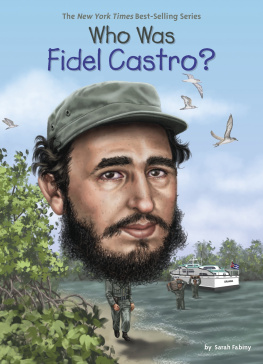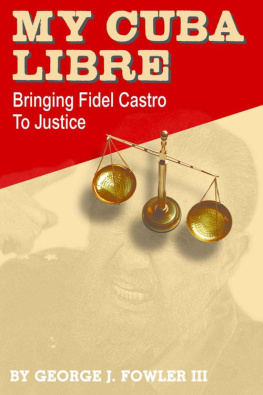COVERING CASTRO
Books by Jay Malln Sr.
Fortress Cuba
Caribbean Crisis
Terror in Viet Nam
Che Guevara on Revolution
Strategy for Conquest
Terror and Urban Guerrillas
Spy for Fidel (ghost-written)
Merc: American Soldiers of Fortune (co-written)
COVERING CASTRO
RISE AND DECLINE OF CUBAS COMMUNIST DICTATOR
JAY MALLIN SR.
First published 1994 by Transaction Publishers
This book is co-published by U.S.-Cuba Institute Press.
Published 2017 by Routledge
2 Park Square, Milton Park, Abingdon, Oxon 0X14 4RN
711 Third Avenue, New York, NY 10017
Routledge is an imprint of the Taylor and Francis Group, an informa business
Copyright 1994 by Jay Mallin, Sr.
All rights reserved. No part of this book may be reprinted or reproduced or utilised in any form or by any electronic, mechanical, or other means, now known or hereafter invented, including photocopying and recording, or in any information storage or retrieval system, without permission in writing from the publishers.
Notice:
Product or corporate names may be trademarks or registered trademarks, and are used only for identification and explanation without intent to infringe.
Library of Congress Catalog Number: 93-46178
Library of Congress Cataloging-in-Publication Data
Mallin, Jay.
Covering Castro: rise and decline of Cubas communist dictator/Jay Mallin Sr.1st ed.
p. cm.
Includes index.
ISBN 1-56000-156-9
1. Castro, Fidel, 1927-2. Cuba-History-1959-. 3. Cuba-Foreign relations1959- . I. Title.
F1788.22.C3M25 1994
972.91064-dc20 93-46178
CIP
pp. 15-36Copyright by Henry Regnery Company. Reprinted by permission.
pp. 37-41Copyright by University of Miami Press. Reprinted by permission.
pp. 57-65The Communists, from Caribbean Crisis by Jay Mallin, copyright by Jay Mallin. Used by permission of Doubleday, a division of Bantam Doubleday Dell Publishing Group, Inc.
pp. 67-84Copyright by University of Miami Press. Reprinted by permission
pp. 97-111Reprinted by permission of the Research Institute for Cuban Studies, University of Miami
pp. 113-131Copyright by E.A. Seemann Publishing, Inc., Reprinted by permission.
pp. 133-146Castros Spies, five part series from The Washington Times. Reprinted by permission.
pp. 147-150Copyright 1982 by The Readers Digest Assn., Inc., Reprinted from the August 1982 Readers Digest by permission.
ISBN 13: 978-1-56000-156-0 (hbk)
TO KELSEY AND BRENNAN WHO WILL SEE A FREE CUBA
Ralph J. Galliano helped to develop the concept of this book and encouraged the author and assisted the editor in putting it together.
TABLE OF CONTENTS
I have seen the Sphinx, the Berlin Wall, the endless plains of Africa, the dense jungles of Panama, the magnificent mountains of Bolivia. I have gazed upon the My Tho in Viet Nam, the Nile in Egypt, the Amazon in Brazil. I have flown over the Alps and the Andes, witnessed the terrible devastation of the last Managua earthquake and seen Paris epic celebration of the bicentennial of the French Revolution. I have been tear-gassed in Montevideo and ambushed in Santo Domingo and I introduced Ernest Hemingway and Graham Greene to each other at Sloppy Joes in Havana (it was perfunctory; they didnt like each other). I have covered some eight wars and many other violent manifestations of the human condition.

Over the long run, however, none of these compares with the fascination of watching and reporting the deeds and misdeeds, declarations and declamations of Fidel Castro Ruz. I have done this for more than 35 years. Voluble, charismatic and utterly ruthless, Castro has sometimes veered close to the antic, but he has also on occasion achieved center stage alongside leaders of world powers. The late dictator of the Dominican Republic, Rafael Lenidas Trujillo, is said to have commented, It is my tragedy to have been born to lead a small nation. Leading a small country has not kept Castro from placing himself in the international spotlight, nor from extending his power into other nations, some of them far distant.
Nikita Khrushchev said Castro was a very hot-tempered person. TV producer Bill Cran called Castro a silly, impractical man. Academician Jaime Suchlicki saw him as a profoundly anti-American, megalomaniac and cunning leader. To academician Gillian Gunn, Castro was a man trying to survive in a radically changed world. Author Robert Stone said of him:
He... was a soldier, a knight offaith. He may have been the only Marxist head of state on earth who actually believed in the doctrine. For that he probably deserves to be left holding the bag.
Castro is multi-faceted; all these descriptions are accurate.
Castro came to fame when he unsuccessfully attacked Moncada Fortress in 1953. I had started my journalism career, working on the Havana Herald. The last time I saw the Maximo Liderl was aboard Jesse Jacksons campaign plane in 1984 during a stop in Havana. Castro came aboard, we chatted andgood heavens!he put an arm around me.
In 1993, Castro is still in power. For this reporter, covering him has been exciting, frustrating, challenging, hazardous and, in professional terms, highly satisfying. This book has some of the material written over a span of a good many years about one of the most colorful and dangerous persons of our time.
JayMallinSr. |
Washington, D.C. |
November 10,1993 |
COVERING CASTRO
RISE AND DECLINE OF CUBAS COMMUNIST DICTATOR
In late 1956, Fidel Castro sailed for Cuba from Mexico with 81 other expeditionaries. Their landing was supposed to coincide with an uprising by the 26th of July Movement in Santiago de Cuba, the countrys second city. But the rebellion occurred before Castro could land, and it was crushed by the Army. When the expedition debarked near the town of Manzanillo, it was quickly decimated by government troops. Castro and his tiny remaining band fled into the nearby Sierra Maestra Mountains. This article, published in the Marine Corps Gazette, describes the 2-year campaign that followed.
On the morning of 27 November 1956, a cable from Mexico was received in Santiago de Cuba. Decoded, the message read simply, Requested edition sold out.
Fidel Castro Ruz and 81 other expeditionaries had sailed from the port of Tuxpn in Mexico aboard the 43-foot yacht Granma, and the Cuban Revolution was about to begin. Its repercussions would one day shake the world.
The cable from Mexico was directed to the underground organization of Castros 26th of July Movement in Santiago. It notified the underground that Castro had sailed, and an action plan was to be set in motion.
Just before dawn on the morning of 30 November, the rebel underground rose up in Santiago and attempted to seize control of the city, second in importance only to Havana. Two rebel cars pulled up in front of the wooden police headquarters in Santiago, and young rebels piled out of the vehicles and began firing at the building and at the police guarding it. Simultaneously other rebels fired at the station from the roof of an adjoining building. The rebels threw grenades and Molotov cocktails, and soon the structure was blazing and ammunition inside was exploding. The police fired back at the rebels, but after an hour the battle was over. The police head-quarters was destroyed.




